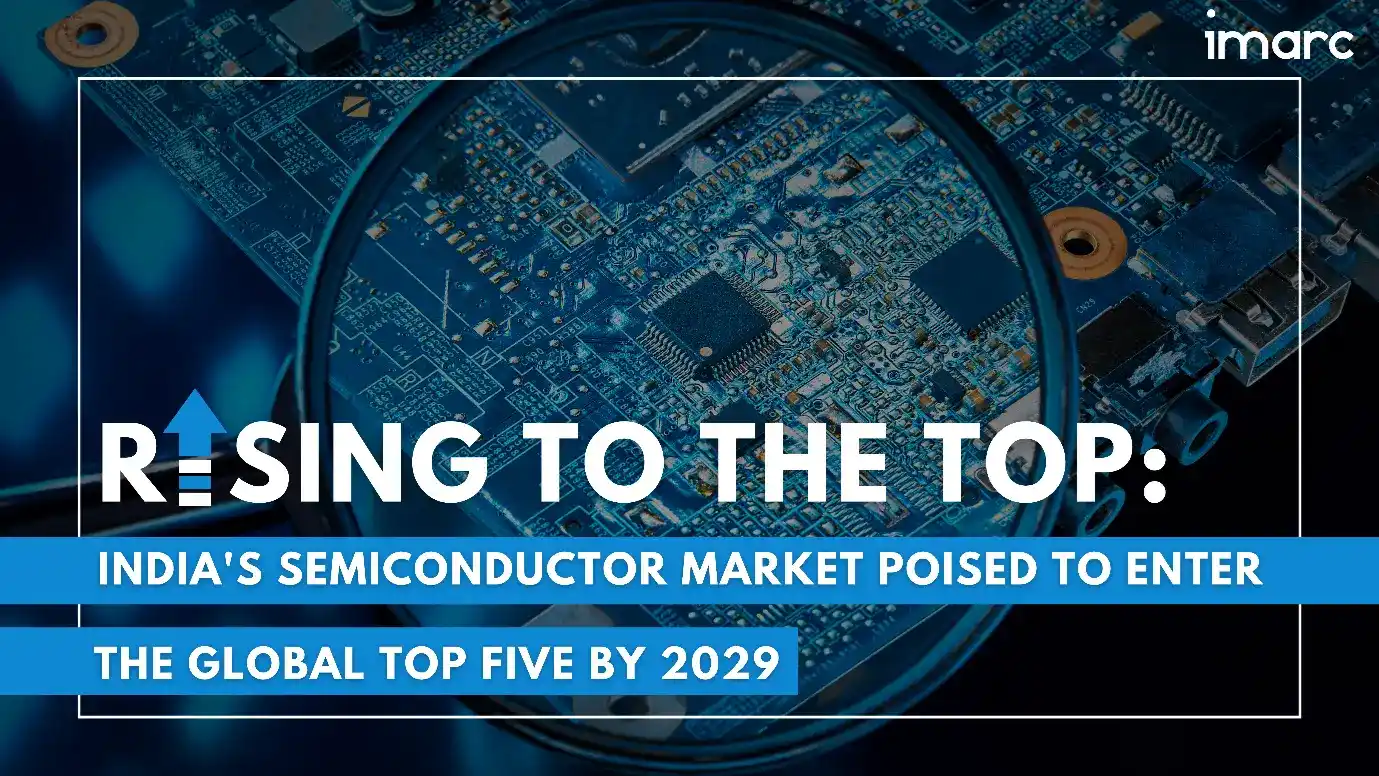Illuminating Profits: A Comprehensive Cost Model for LED Chip Manufacturing
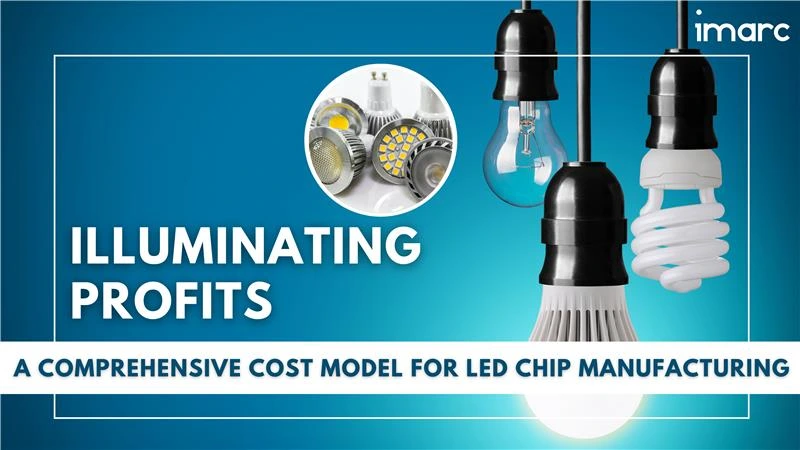
The LED chip is the core component of an LED bulb, comprising semiconductor layers that enable the free flow of protons and electrons. Employed in all LED lighting fixtures—from bulbs to tubes—the LED chip fundamentally determines light quality, with variations in brightness, voltage, and wavelength. These chips are manufactured through a process called MOCVD (metal-organic chemical vapor deposition), which creates the semiconductor layers that facilitate electric flow. Major applications of these chips include backlighting, illumination, automotive lighting, signs, and signals.
The global LED chip market was valued at US$ 28.1 Billion in 2023. According to IMARC Group, the market is projected to reach US$ 75.5 Billion by 2032, growing at a CAGR of 11.3% from 2024 to 2032. The market is primarily driven by a growing preference for cost-effective lighting solutions and increasing awareness of energy conservation, which significantly boosts demand for these products. Furthermore, ongoing technological advancements and extensive research and development (R&D) efforts have reduced the average cost of LEDs, which serves as a key growth driver.
Various governments worldwide are promoting energy-efficient lighting solutions, further supporting LED chip sales. Rapid urbanization, robust growth in the real estate sector, and rising disposable incomes are also contributing to a positive global market outlook. Additionally, innovation has propelled market demand, with companies introducing advanced products to meet evolving needs. For example, in 2020, Osram launched its projector power series of LED chips, delivering a brightness of 1000 ANSI lumens. Such advancements have broadened applications across various industries, supporting global market growth.
Case Study on Cost Model of LED Chip Manufacturing Plant
One of our clients reached out to us to conduct a feasibility study for setting up a mid to large-scale LED chips manufacturing plant. We developed a comprehensive financial model for the setup and operation of a proposed LED chip manufacturing plant in India. This plant is designed to produce approximately 336 wafers, or around 12,000 LED chips per day, covering a land area of 4,400 square meters.
Manufacturing Process: LED chip manufacturing spans several stages: epitaxial growth, chip fabrication, wafer processing, and backend processing. Epitaxial growth uses MOCVD technology to form layers in the LED structure, such as the GaN buffer and MQW active region, enhancing LED performance through improved process control, gas flow, and temperature uniformity. In the chip fabrication stage, semiconductor layers are patterned, and metal layers are deposited to create electrical contacts, followed by surface texturing to improve light extraction. Wafer processing includes p-contact layer formation, mesa etching for n-GaN exposure, and metallization, providing connections to the LED package. The wafer is then thinned, usually by grinding and laser lift-off. Backend processing involves die singulation and testing. During laser scribing, the wafer is prepared for individual die separation with precision. Next, film frame mounters hold the wafer during singulation while die expanders stretch it for testing and placement. This process enables efficient LED chip production, ensuring consistent quality and performance.
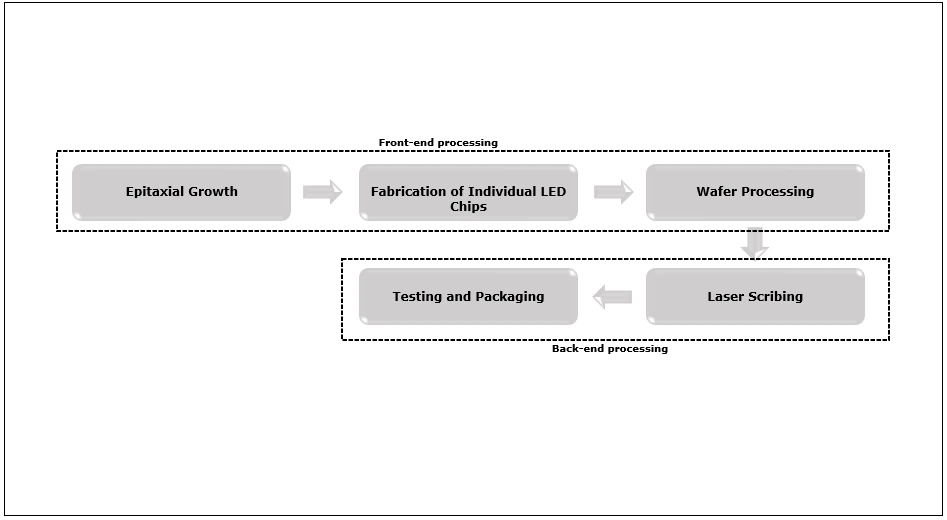
Mass Balance and Raw Material Required: The primary raw materials used in the LED chips manufacturing plant include acetone, AuSn solder, GaN etchant, developer, etcher Ag, etchant metal, zeolite slurry, hydrogen gas, nitrogen gas, ammonia, oxygen gas, and various other components.
Table: Mass Balance: Raw Material Required for Wafer (equivalent to 12,000 LED Chips)
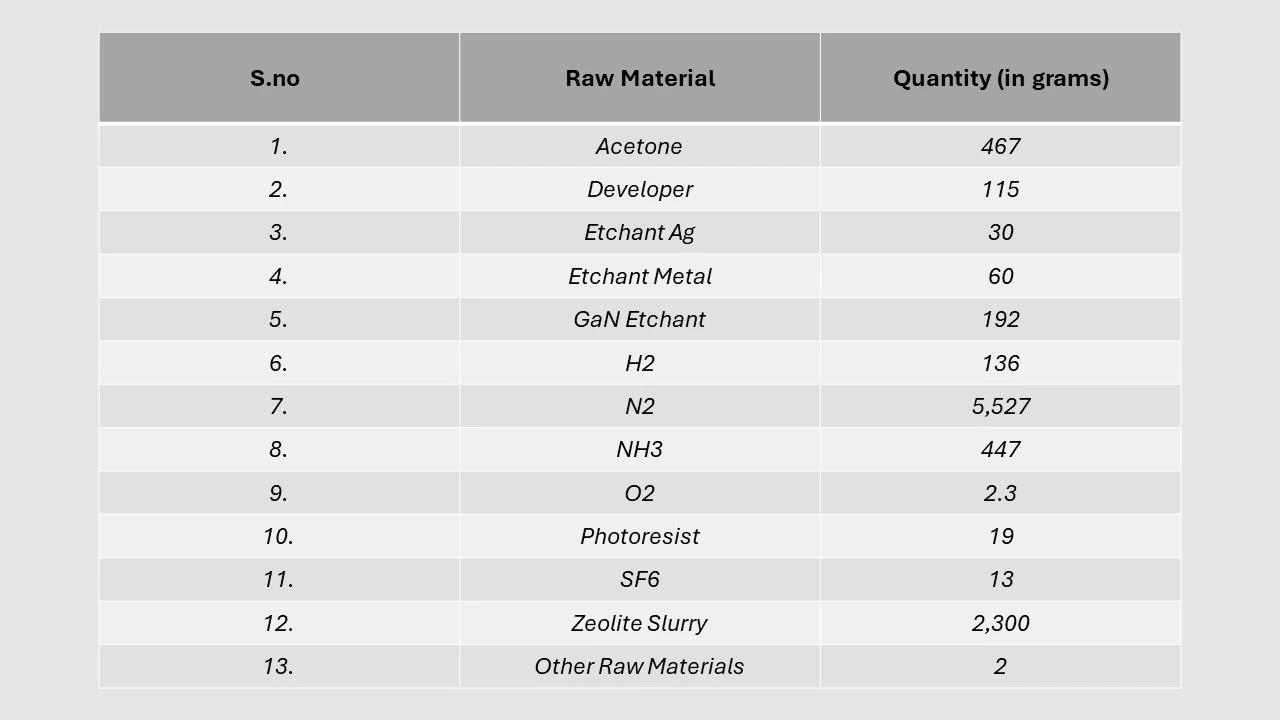
Note: Other raw materials include AuSn Solder, SF6, SiH4, Target Ag, Target Al, Target Ni, Target Ti, Target W, TMAI, TMGa and TMln
List of Machinery:
The following equipment was required for the proposed plant:
- MOCVD
- Lithography Machine
- Plasma Etcher
- Laser Lift-off
- Laser Scriber
- Breaker
- Film Mounter
- Die Expander
- UV Tape UV Curing Systems
- Ultrapure Water Purification System
Techno-Commercial Parameter:
- Breakup by Capital Investment: The total capital cost for establishing the proposed LED chip production plant is approximately INR 43.9 Crore. Notably, plant machinery costs account for 94.3% of the total capital expenditure (CapEx). In addition to the initial investment in machinery and equipment, several other key factors are critical to the establishment of LED light manufacturing plants. These include facility costs, which cover land acquisition or leasing expenses, as well as construction costs for manufacturing and assembly spaces. Furthermore, investments in utilities and infrastructure—such as power, water, and waste management systems—are essential to meet the energy requirements necessary for both manufacturing and quality control processes.
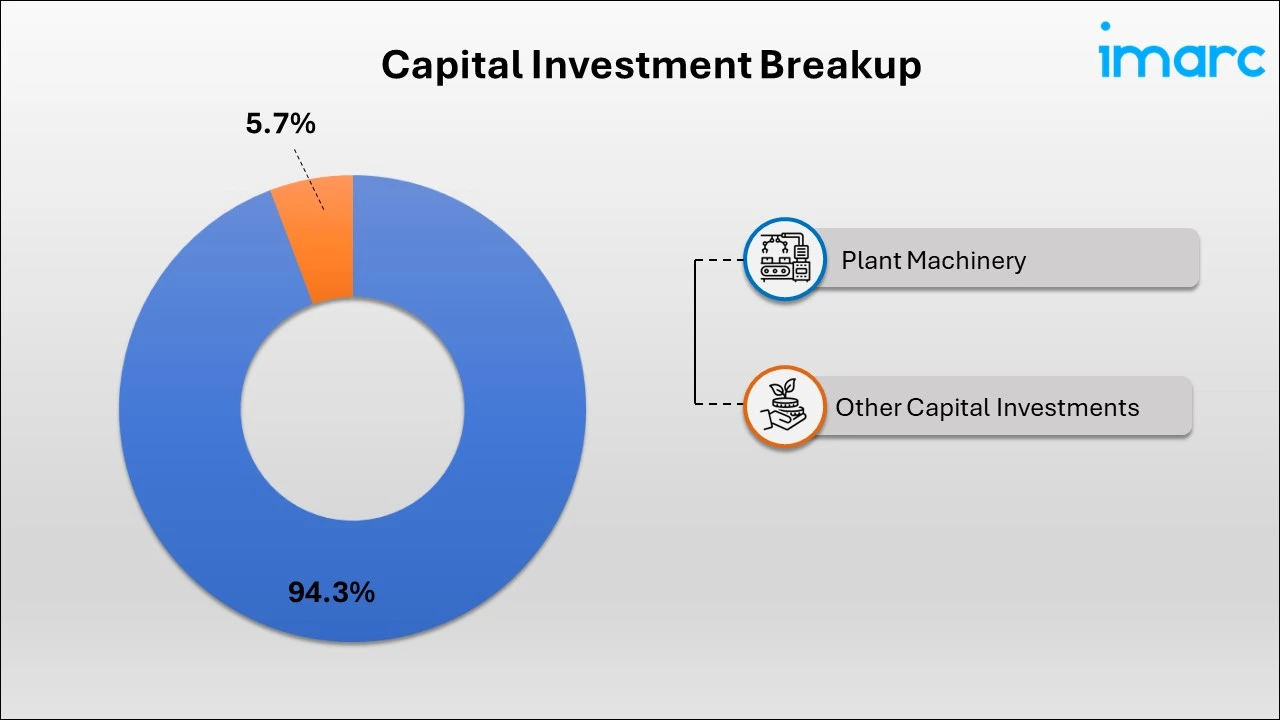
- Breakup by Expenditure: In an LED chip manufacturing plant, the cost of raw materials for the first year of operation is estimated to be INR 5.40 Crore. By the fifth year of operation, this cost is projected to increase by 21.3% compared to the first year. This rise in raw material expenses reflects anticipated market trends and inflation factors that may impact the cost structure of LED chip production over the years. In addition to raw materials, installment payments and interest expenses represent a significant portion of the total expenditure, given the proposed equity-to-debt ratio of 5:95.
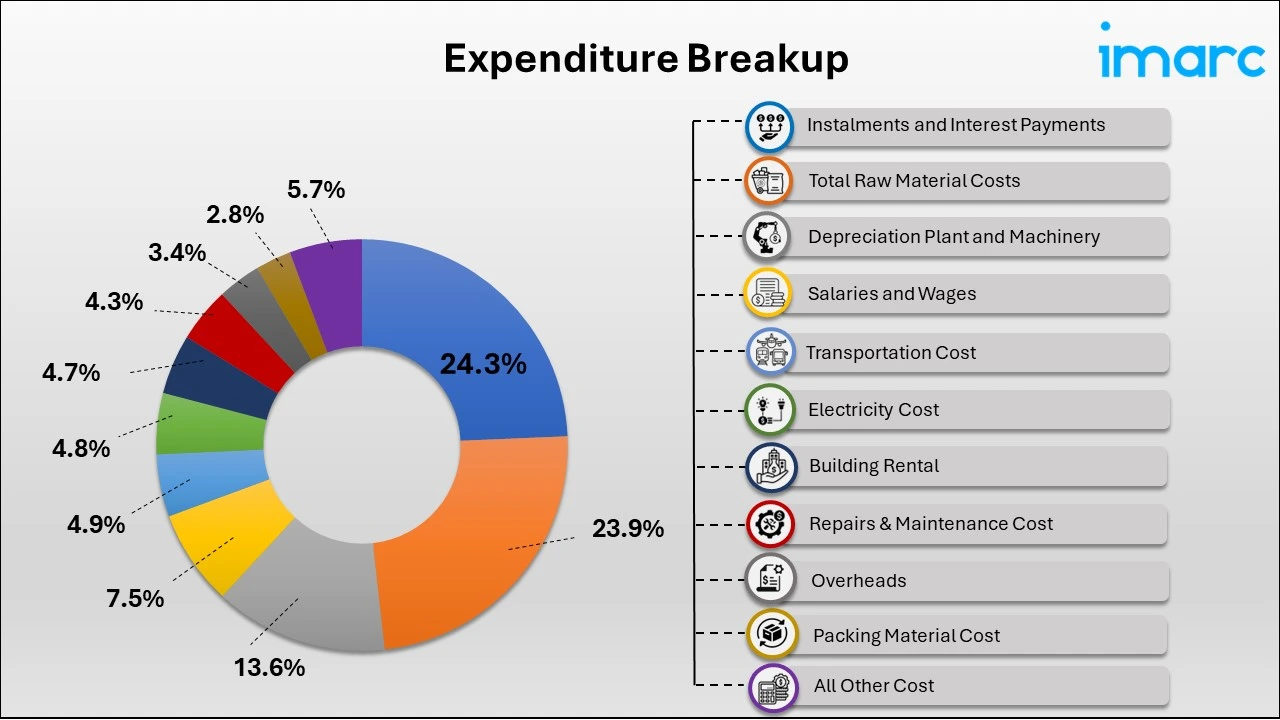
- Profitability Analysis Year on Year Basis
(All values are in INR Crore, except % ages)
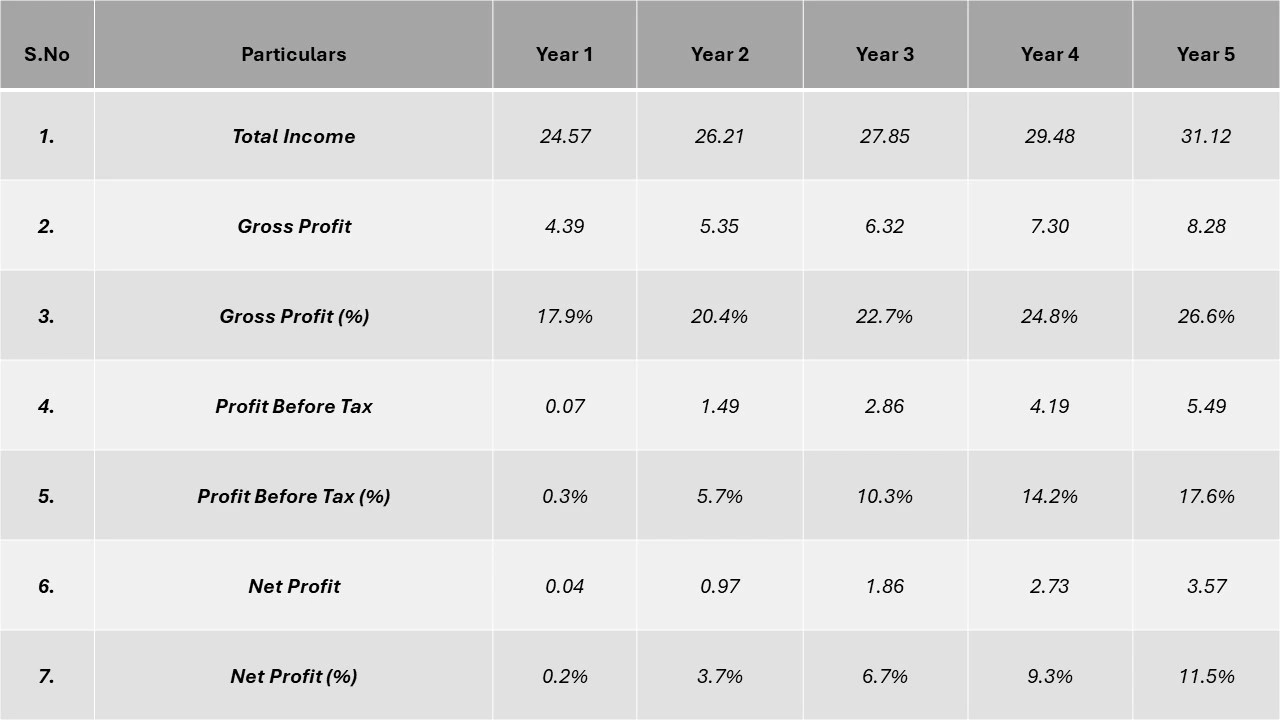
Conclusion
Our financial model for the LED chips manufacturing plant was meticulously developed to meet the client’s objectives, providing an in-depth analysis of production costs, including raw materials, manufacturing, capital expenditure, and operational expenses. By addressing the specific requirements of producing 336 wafers per day, we successfully identified key cost drivers and projected profitability, considering market trends, inflation, and potential fluctuations in raw material prices. This comprehensive financial model equipped the client with valuable insights for strategic decision-making, demonstrating our commitment to delivering high-quality, client-focused solutions that ensure the long-term success of large-scale manufacturing ventures.
Driving Success with IMARC’s Financial Models: Navigating Industry Economics with Precision
IMARC is a global market research company offering an extensive suite of services tailored to support businesses at every stage of their growth journey, including market entry, competitive intelligence, procurement research, regulatory approvals, factory setup, company incorporation, and recruitment. Under our factory setup services, we provide clients with in-depth financial cost modeling to assess the feasibility and financial viability of new manufacturing plants, both in India and internationally.
Our financial modeling includes a thorough analysis of capital expenditure (CapEx) needed to establish a manufacturing facility, addressing costs such as land acquisition, building infrastructure, and the purchase and installation of high-tech equipment. This model also considers the impact of factory layout and design on operational efficiency, energy consumption, and workforce productivity, providing a comprehensive view of factors that influence long-term operational expenditure (OpEx). Each of these parameters is carefully evaluated to present clients with a robust and accurate cost assessment, ensuring that all major and minor aspects of plant setup are accounted for.
Contact Us
Have a question or need assistance? Please complete the form with your inquiry or reach out by emailing us on sales@imarcgroup.com.
